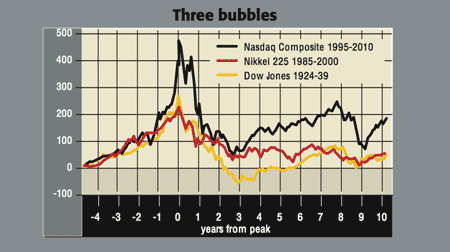
Global Financial Stability Reports are never a light read. Even so, last autumn’s was grim. The IMF said that only around half of the $3.4trn of likely total credit-crunch losses by the end of this year had been acknowledged, and the risk to financial stability remained high. This January’s update wasn’t much cheerier. Over two years after the credit crunch began, it expects more trouble from the financial sector: “continued bank write-downs, funding pressures and weak credit growth”. And given the banking outlook in the US, Britain and Europe, there’s little prospect of a big boost to lending, and hence growth, anytime soon.
The next US subprime?
“The rot in the US banking system” is set to “warp an already weak economic recovery”, says Colin Barr in Fortune. The government expects bank failures this year to surpass 2009’s 140 as banks still struggling with bad mortgages gird themselves for a “massive commercial-real-estate bust”. Losses could reach $200bn-$300bn and will mostly hit small lenders.
Meanwhile, few bank analysts have factored in a renewed slide in American residential property prices. But given the excess supply in the market amid “alarming” foreclosure levels, a price slide of 10%-15% is on the cards, reckons David Rosenberg of Gluskin Sheff. Foreclosures will “rocket” this year as so-called option-adjustable-rate mortgages reset, says Gary Halbert of Profutures. These are loans taken out by people with good credit scores during the height of the boom. Initial payments are low, but they jump after a few years.
The bulk of these loans will reset later this year and in 2011. Many borrowers will see monthly payments rise by 50% or more. For the 85% of option-ARM holders in negative equity, refinancing into a more affordable loan is impossible. More than $10bn of option-ARMs are due to reset per month by the middle of next year, and Standard & Poor’s estimates that almost 40% of option-ARMs written in 2007 will go bad. No wonder some see this as “the next subprime disaster”, says Halbert.
Creditless recovery in Europe
Europe, too, is facing a “creditless recovery”, says Morgan Stanley. One issue is that “European banking is heavily exposed to southern Europe and Greece in particular”, notes Société Générale. The joint exposure of French and German banks to Portuguese, Greek, Irish and Spanish debt (government, corporate and individual) is around e664bn. Austerity packages threaten to raise defaults on southern European loans. Greece is likely to have to cut even more than it has planned this year to meet its deficit-reduction targets. That will cause an even deeper downturn, says Capital Economics. In Spain, bad debts tripled in the year to September, and lending to firms fell by 38% in the year to January, says James Saft on Reuters.com.
A funding chasm for British banks
Meanwhile, European banks will have to renew around half of their e3.3trn of wholesale funding in 2010-2012, reckons Morgan Stanley. British banks alone will need to find around £440bn by 2012, according to the Financial Services Authority. Of this sum, £300bn is to make up for loans provided by the Bank of England, which will wind up its support over the next few years. Talk about a funding “chasm”, says Andrew Ellson in The Times. That said, the bottom line is that, “for the right price there will always be lenders to the UK banking system”, says Jeremy Warner on Telegraph.co.uk. But the price will be a high one, the cost of credit will rise regardless of the base rate. And then there’s the threat of a double-dip recession “leading to another raft of bad debts” on bank balance sheets. Be warned: there is “an awfully long way to go before we can declare the crisis over”.
The big picture: no quick fix for the Nasdaq
Human nature doesn’t change, says John Authers in the FT. Add cheap credit to a “plausible new idea” and soon there will be a rush into the market. Greed trumps fear, sending prices to absurd levels. Like the Dutch tulip mania of the 17th century, Japan in the years to 1989, and Wall Street pre-1929, the Nasdaq Composite’s run-up to its 2000 peak was “one of history’s great irrational and speculative bubbles”. And, as with previous bubbles, there has been no quick recovery from the dotcom crash. The Nasdaq is still at around 2,300 and won’t get back to 5,000 “in a hurry”, says James Paulsen of Wells Capital.
Statistic of the week
“There is no neater summation of Japan’s rise and fall” than the number of foreign listings on the Tokyo Stock Exchange, says Lex in the FT. In 1973, when the exchange opened to overseas companies, six floated. By 1991, two years after the bubble peaked, 127 had arrived. But since 1992, departures have outnumbered arrivals every year. By the end of April, there will only be 12 foreign firms on the exchange.